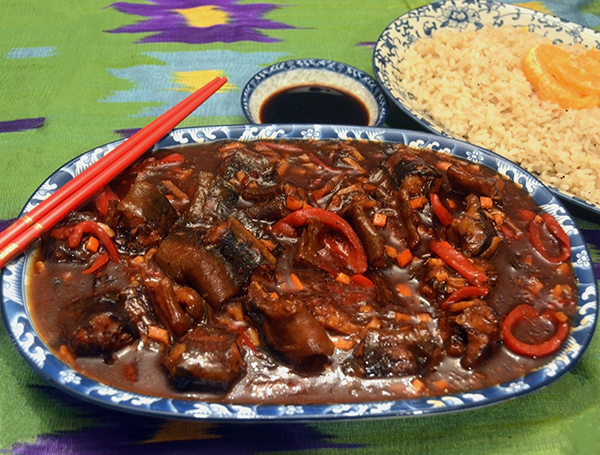
I grew up in a very closely knit Italian-American community in the suburbs of New York City. Nearly everyone I knew as a child was related to me by blood or marriage. It was a world of cousins. There was an Italian-American club where old men played bocce, crazy car-horns that played the tarantella, and there was the great, carnival-like Summer Festa, that seemed to bring the whole town out to Saint Anthony’s school to gamble, play games, and, of course, eat. Food was everywhere, and people loved eating – not just at the Festa but in everyday life. Sunday dinners were serious business, and you didn’t skip them without a really good excuse.
So, when Sasha Martin, of the Global Table Adventure, asked me to participate in her Feast of Seven Fishes event, I had to pause and wonder how I had missed out on this wonderful Christmas-Eve tradition growing up. A little research and I found out that it is specifically an Italian-American Christmas-Eve event that is practiced by people who came from southern Italy. (That would rule out my ancestors who were from an area between Bologna and Ravenna.) It also is a relatively new concept that has been quickly growing in popularity since Mario Batali and other Food Network stars started demonstrating recipes for special Christmas Eve fish-only dinners. There are even restaurants that now offer special menus for people wishing to celebrate the Feast.
The seven fishes that either stand for the seven sacraments or the number of days that it supposedly took God to create the universe. Sometimes, there are more than seven dishes – nine for three times the holy trinity, or 13 for the apostles plus Jesus. No matter the number of dishes, there always seems to be an effort to couple them with an element of religious symbolism. A Christmas Eve fish-themed dinner. It must be an American concept. Americans love theme dinners.
On to my own recipe for Sasha’s Feast: Sweet and Savory Eel – Chinese Style. What is a Chinese dish doing at an Italian-American feast? Well, Silk Road, Marco Polo . . . it fits, in a loosely-tight sort of way. Actually, Italians of all varieties love eel and eat it when they can, and there are loads of wonderful recipes for it from the Mediterranean and beyond. Its my job to focus on the beyond. So, Sweet and Savory Eel. This recipe is adapted from a Chinese homestyle recipe, generously shared with me by my friend Dimon. It is delicious, easy to prepare, and well worth the effort of handling the slimy beasts. Lots of ginger and garlic form the base of the savory brown sauce with tangerine peel, maple syrup, and a few chili peppers providing the grace notes.

Chinese Sweet and Savory Eel
Ingredients
1.5 – 2 pounds fresh eel, cut into 1.5 inch sections
Tapioca flour as needed (for dusting)
3-4 tablespoons of corn oil
1 tablespoon sesame oil
1 small bunch (4-6) spring onions, chopped
2 -3 inch piece of fresh ginger, peeled and thinly sliced
5-6 garlic cloves, peeled and thinly sliced
Peels from 2 tangerines, dried and thinly sliced, or minced
3-4 dried red chili peppers, diced (I use Japones)
2 cups of brown rice wine
3 tablespoons dark soy sauce (or a mix of dark and light)
3 tablespoons maple syrup
1 cup water or fish stock
1 sweet, red bell pepper, thinly sliced
Directions
Dust the eel slices with tapioca flour, and tap on the edge of a plate when done to remove excess flour. Heat corn oil in a large sauté pan until smoking hot. Add the coated eel slices and sauté until golden. Remove eel from the pan with a slotted spoon and let cool on a plate.
Drain off most of the corn oil and add sesame oil to sauté pan and warm it up. Add spring onions and sauté until they start to soften. Then add the garlic and ginger slices and cook on low-to-medium, stirring often, until the ginger colors or the garlic swells. Add the tangerine peel and chillies and cook well, adding part of the rice wine to moisten as needed.
Add the rest of the rice wine and heat to almost boiling. Reduce the heat, and immediately add the eel slices. Cook on a low-to-medium simmer for five minutes, then add the dark soy sauce and the maple syrup, cover, and lower the heat to a low simmer. Cook for 15-20 minutes. Then add water or fish stock to moisten the sauce and bring back to a simmer. Add the sliced peppers, then cover and cook for another 15-20 minutes until the eel is beginning to soften. Stir well and cook for another 10 minutes or so until eel is soft, and peppers are cooked. Depending on the desired consistency of the sauce, you may cook uncovered if you want a thicker sauce.
Serve with rice, tangerine slices, more spring onions, or the condiments of your choice.
_____
NB: To be authentically Chinese, the eel should be a river eel or swamp eel. The salt-water eels often used in other cuisines would offer a much sharper flavor and change the recipe significantly. The right type of eel are usually sold live at larger Asian markets. You can ask the fish mongers to cut and clean the animals to order, to minimize handling them. This is an important bit of advice to consider, because when eels get stressed (like when a fish monger reaches into a bucket, grabs them), they get even more slimy than usual. If you ever taken a graduate genetics lab, and know what its like to handle stressed hagfish – this is exactly the same.
_____
The Feast of Seven Fishes undoubtedly has its roots in the traditional Italian vigil feast, which is celebrated all over Italy. However, unlike those feasts, the Feast of Seven Fishes is a fish-only extravaganza with the number of dishes symbolically tied to Catholic themes. At a traditional vigil feast, for example, one would be unlikely to find meat dishes (at least in a strictly Catholic home), but you would find meat-based soups (like a chicken broth with tortellini or “cap-lets” as we grew up calling them), sauces with meat stock or broth in them, butter, cheese and eggs – all meat products.
Also, how the Church has defined, “meat” over the years is really fascinating. Generally, the prohibition extends only to terrestrial mammals and birds; whereas aquatic animals of all types were allowed. At different times in history, the Church has also allowed Catholics to eat mammals that spend a lot of time in water during lent and other no-meat fast and vigil days. This means that Catholics in Quebec ate beaver and Latin Catholics ate (and still do eat) capybara on no-meat Fridays or in times of fasting. Likewise, reptiles and amphibians are on the Lenten or fasting menu in places where it is traditional for the secular populous to eat them.
What I suspect is the Feast of Seven Fishes was a tradition in a very local part of Southern Italy – probably somewhere deep in the foot of the boot – that immigrants brought with them. It spread within the neighborhoods they emigrated to and is now being projected back as broadly, “Italian,” by their descendants and others who have adopted the practice.
Although I am a stickler for detail, to me it’s wonderful and interesting that the Feast of Seven Fishes is taking on a life of its own in the New World of the 20th and 21st Centuries. It is the birth of a new food tradition, right before our eyes! And another example of how cuisines are constantly evolving. Whenever you try this recipe, whether for the Feast of Seven Fishes or at some other time, prepare it and share it with loved ones – now, that’s Italian!
Expand your Feast of the 7 Fishes menu with these delicious ideas:
Salt Cod Tomato Sauce with Linguine by Sasha Martin, Global Table Adventure.
Sicilian Citrus Shark Filets by Amanda Mouttaki, MarocMama.
Whipped Salt cod | Baccalà Mantecato by Deana Sidney, Lost Past Remembered.
To read more about Italy on the Silk Road, check my earlier posts.
Lots of other great Silk Road fish recipes here on the site, including a Bhutanese curry of Fish and Oranges
(Words by Laura Kelley; photograph of Pete serving food at the Festa borrowed from a St. Anthony of Padua newsletter, photograph of Chinese Sweet and Savory Eel by Laura Kelley.)
